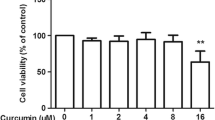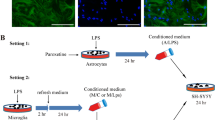Abstract
The role of the interaction between neurons and glial cells in the pathogenesis of neurodegenerative diseases is gaining more attention. Neuroinflammation participates in the progressive nature of diverse neurologic diseases including Parkinson's disease, Alzheimer's disease and multiple sclerosis. Activated microglia release neurotoxic molecules, which take part in the neuroinflammatory responses. Astrocytes are also key players in these responses. Reactive astrocytes secrete inflammatory factors, including tumor necrosis factor-α (TNF-α). This secretion can be regulated by extracellular ATP mediated through P2X7 receptors. However, whether the activity of astrocytic P2X7 receptors changes in Parkinson’s disease and whether these changes would influence the secretion of inflammatory factors in astrocytes are still unclear. In our study, through immunocytochemistry, whole-cell patch clamp and ELISA assay, we found that P2X7 receptors were expressed in midbrain astrocytes, and that, rotenone, a Parkinson’s disease model used at a low concentration (2–20 nM) for 48 h increased the P2X7 receptor current density and thereby inhibited the secretion of TNF-α. Our research suggests that rotenone can regulate cytokine secretion of astrocytes through elevated P2X7 channel current density and, in turn, take part in the neuroinflammatory process in the rotenone Parkinson’s disease model.




Similar content being viewed by others
References
Levesque S, Wilson B, Gregoria V, Thorpe LB, Dallas S, Polikov VS, Hong JS, Block ML (2010) Reactive microgliosis: extracellular micro-calpain and microglia-mediated dopaminergic neurotoxicity. Brain 133(Pt 3):808–821
Sugama S, Takenouchi T, Cho BP, Joh TH, Hashimoto M, Kitani H (2009) Possible roles of microglial cells for neurotoxicity in clinical neurodegenerative diseases and experimental animal models. Inflamm Allergy Drug Targets 8:277–284
Verkhratsky A, Krishtal OA, Burnstock G (2009) Purinoceptors on neuroglia. Mol Neurobiol 39:190–208
Forno LS, DeLanney LE, Irwin I, Di Monte D, Langston JW (1992) Astrocytes and Parkinson's disease. Prog Brain Res 94:429–436
Mirza B, Hadberg H, Thomsen P, Moos T (2000) The absence of reactive astrocytosis is indicative of a unique inflammatory process in Parkinson's disease. Neuroscience 95:425–432
Sofroniew MV (2009) Molecular dissection of reactive astrogliosis and glial scar formation. Trends Neurosci 32:638–647
Duan S, Neary JT (2006) P2X7 receptors: properties and relevance to CNS function. Glia 54:738–746
Kucher BM, Neary JT (2005) Bi-functional effects of ATP/P2 receptor activation on tumor necrosis factor-alpha release in lipopolysaccharide-stimulated astrocytes. J Neurochem 92:525–535
Duan S, Anderson CM, Keung EC, Chen Y, Chen Y, Swanson RA (2003) P2X7 receptor-mediated release of excitatory amino acids from astrocytes. J Neurosci 23:1320–1328
Bianco F, Perrotta C, Novellino L, Francolini M, Riganti L, Menna E, Saglietti L, Schuchman EH, Furlan R, Clementi E, Matteoli M, Verderio C (2009) Acid sphingomyelinase activity triggers microparticle release from glial cells. EMBO J 28:1043–1054
McNaught KS, Jenner P (2000) Extracellular accumulation of nitric oxide, hydrogen peroxide, and glutamate in astrocytic cultures following glutathione depletion, complex I inhibition, and/or lipopolysaccharide-induced activation. Biochem Pharmacol 60:979–988
McCarthy KD, de Vellis J (1980) Preparation of separate astroglial and oligodendroglial cell cultures from rat cerebral tissue. J Cell Biol 85:890–902
Fernandes A, Falcão AS, Silva RF, Brito MA, Brites D (2007) MAPKs are key players in mediating cytokine release and cell death induced by unconjugated bilirubin in cultured rat cortical astrocytes. Eur J Neurosci 25:1058–1068
Kukley M, Barden JA, Steinhäuser C, Jabs R (2001) Distribution of P2X receptors on astrocytes in juvenile rat hippocampus. Glia 36:11–21
Carrasquero LM, Delicado EG, Bustillo D, Gutiérrez-Martín Y, Artalejo AR, Miras-Portugal MT (2009) P2X7 and P2Y13 purinergic receptors mediate intracellular calcium responses to BzATP in rat cerebellar astrocytes. J Neurochem 110:879–889
Franke H, Grosche J, Schädlich H, Krügel U, Allgaier C, Illes P (2001) P2X receptor expression on astrocytes in the nucleus accumbens of rats. Neuroscience 108:421–429
Franke H, Günther A, Grosche J, Schmidt R, Rossner S, Reinhardt R, Faber-Zuschratter H, Schneider D, Illes P (2004) P2X7 receptor expression after ischemia in the cerebral cortex of rats. J Neuropathol Exp Neurol 63:686–699
Jabs R, Matthias K, Grote A, Grauer M, Seifert G, Steinhäuser C (2007) Lack of P2X receptor mediated currents in astrocytes and GluR type glial cells of the hippocampal CA1 region. Glia 55:1648–1655
Betarbet R, Sherer TB, MacKenzie G, Garcia-Osuna M, Panov AV, Greenamyre JT (2000) Chronic systemic pesticide exposure reproduces features of Parkinson's disease. Nat Neurosci 3:1301–1306
Porter RH, Greene JG, Higgins DS Jr, Greenamyre JT (1994) Polysynaptic regulation of glutamate receptors and mitochondrial enzyme activities in the basal ganglia of rats with unilateral dopamine depletion. J Neurosci 14:7192–7199
Davey GP, Clark JB (1996) Threshold effects and control of oxidative phosphorylation in nonsynaptic rat brain mitochondria. J Neurochem 66:1617–1624
Sims NR (1990) Rapid isolation of metabolically active mitochondria from rat brain and subregions using Percoll density gradient centrifugation. J Neurochem 55:698–707
Ling Z, Chang QA, Tong CW, Leurgans SE, Lipton JW, Carvey PM (2004) Rotenone potentiates dopamine neuron loss in animals exposed to lipopolysaccharide prenatally. Exp Neurol 190:373–383
Mingam R, De Smedt V, Amédée T, Bluthé RM, Kelley KW, Dantzer R, Layé S (2008) In vitro and in vivo evidence for a role of the P2X7 receptor in the release of IL-1 beta in the murine brain. Brain Behav Immun 22:234–244
Bianco F, Pravettoni E, Colombo A, Schenk U, Möller T, Matteoli M, Verderio C (2005) Astrocyte-derived ATP induces vesicle shedding and IL-1 beta release from microglia. J Immunol 174:7268–7277
Burnstock G (2007) Physiology and pathophysiology of purinergic neurotransmission. Physiol Rev 87:659–797
Acknowledgements
Funding
National Natural Science Foundation (30800430), National Key Basic Research Program (2006CB500702, 2007CB947100), The Ministry of Science and Technology of China (2009ZX09311-001).
Study design
Cheng He, Zheng-Hua Xiang, Xiao-Fei Gao
Collection, analysis, and interpretation of data
Xiao-Fei Gao, Wei Wang, Qiang Yu
Writing of the report
Xiao-Fei Gao
Writing assistance
Geoffrey Burnstock
Decision to submit
Cheng He, Zheng-Hua Xiang
Author information
Authors and Affiliations
Corresponding authors
Electronic supplementary material
Below is the link to the electronic supplementary material.
Supplementary Fig. 1
The contrast pictures of cultured astrocytes. a The arrow indicates the hypertrophic astrocyte with long process. b The arrow indicates the astrocyte with flat and polygonal structures. Bar = 50 μm (GIF 25 kb)
Rights and permissions
About this article
Cite this article
Gao, XF., Wang, W., Yu, Q. et al. Astroglial P2X7 receptor current density increased following long-term exposure to rotenone. Purinergic Signalling 7, 65–72 (2011). https://doi.org/10.1007/s11302-011-9218-y
Received:
Accepted:
Published:
Issue Date:
DOI: https://doi.org/10.1007/s11302-011-9218-y




